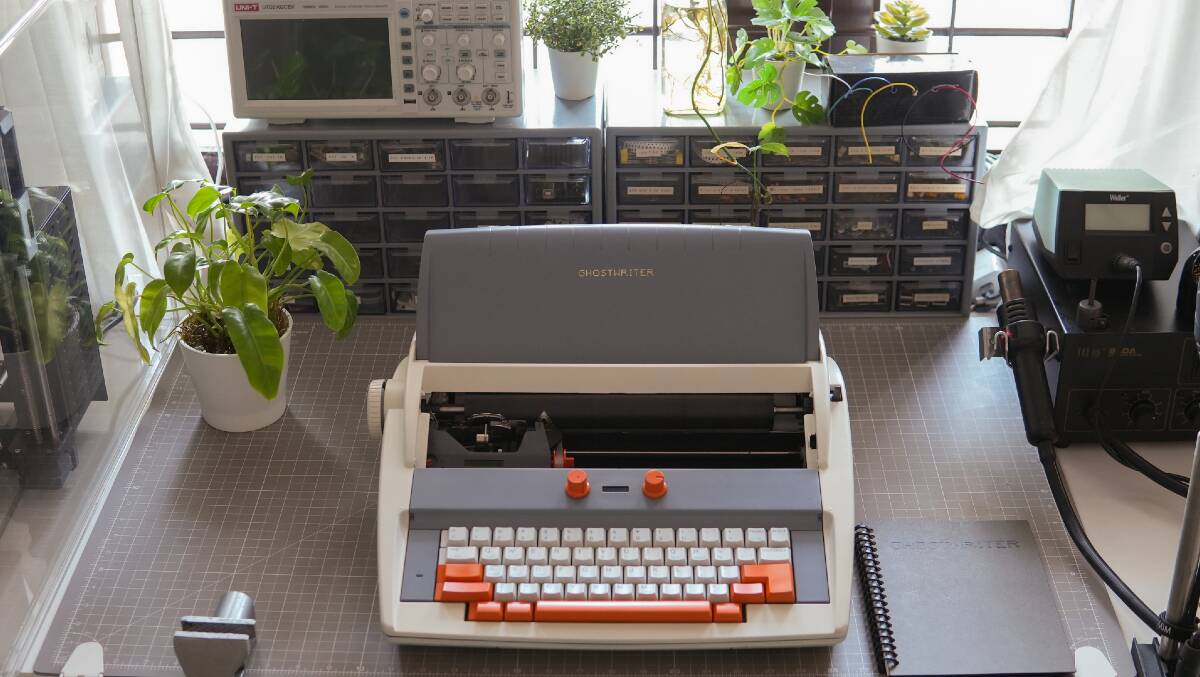The future and the past: Ghostwriter is a talking typewriter driven by artificial intelligence.

In a scene from the 1963 film Who’s Minding the Store?, Jerry Lewis’s character pretends to use a typewriter to the tune of Leroy Anderson’s Typewriter Song. Lewis’s facial expression in that scene and the manner in which he read the entire piece on air are considered to be among the finest performances of his career.
This particular film scene reflected the time period, which was the era of typewriters. Even after nearly 60 years, the clickety-clack noises of typewriters continue to excite fans, and although we rarely see them outside of courts in India, one man is on a quest to bring them back with a twist.
A designer and engineer from Kochi, Kerala, named Arvind Sanjeev has built a typewriter that employs artificial intelligence (AI) to converse with the user. Sanjeev calls the AI-integrated typewriter Ghostwriter a term with a symbolic significance.
Sanjeev’s fondness for ancient technology is part of an ongoing endeavor to recall our past and reinvent it in a modern context. “A typewriter is strictly analogue. At the end of the day, it’s essentially paper and ink as you type prompts into paper and receive responses. “I wanted physical interaction to remain unique to the typewriter,” he told IndianExpress.com through a video call from Kochi.
“We don’t trust these [newer] technologies, but we do trust those things with which we are comfortable,” Sanjeev remarked as he explained why we still cherish antique devices despite their absence from our digital lives.

Reimagining a typewriter
Sanjeev acquired a broken Brother AX-325 electric typewriter from the 1990s on the OLX marketplace two years ago. He then began restoring the machine by purchasing new cartridges and making changes. Following the refurbishment, the machine now has two boards: an Arduino board, a low-cost microcontroller that is used to read the keys, and a Raspberry Pi. The Arduino transmits signals to a Raspberry Pi, which serves as the network interface for OpenAI’s GPT-3, the big language model that drives ChatGPT. “I picked an electronic typewriter over a manual one because it allowed me to reverse engineer and read the typewriter’s keys, similar to how a fax machine works,” he explained.
A great deal of effort was spent reinventing how a typewriter should seem, making it more “futuristic” and technologically advanced while retaining the essence and feel of a gadget from the past. Sanjeev worked on sanding and polishing the item and gave it a bespoke grey, cream, and orange finish. He added two knobs and an OLED display to GPT-3 to manage its “creative temperature” and response time.
Sanjeev had spent nearly a year on the project, yet there were occasions when he nearly gave up. Sanjeev noted, “I was unable to effectively interpret the user’s input, and it took much more time than I anticipated.” Sanjeev notes that establishing proper communication between the typewriter and the OpenAI model was initially difficult, but he kept returning to the problem and considering alternative approaches. “I utilised a Python application to read, query, and transmit the prompts the user types. “It sends it to the open API server, then retrieves the result and types it out on the typewriter,” he explained.
“Meditative method”
Sanjeev, who took on Ghostwriter as a side project in addition to heading the firm behind the Lumen augmented reality device and teaching AI to students, stated that he wished to expose AI to folks who are captivated by historical nostalgia but are also able to live in the present.
“Artificial intelligence on the computer screen can be distracting, but the typewriter is deliberately slow.” We can read each individual character on a typewriter and print it. Thus, we have a great deal of time to absorb all the AI’s nuances, idiosyncrasies, and peculiarities in a contemplative manner,” he explained. “I chose to utilize a mental model of a typewriter, and then I put an AI into it in a very simple way, so that when people write stories, it prompts, it reacts, and it types them back on paper,” he explained.
In the late 1960s, the writing community enthusiastically supported typewriters. When computers were introduced, writers were originally sceptical, but they quickly realised the advantages of a plug-and-play, integrated system with an integrated word processor. Now, many members of the creative world are concerned that the growing popularity of AI chatbots such as ChatGPT could circumvent creativity and replace journalists and writers.
Sanjeev agrees. “The exact opposite is occurring.” After creatives, artists, and designers, AI will arrive before blue-collar laborers. “I can sense a great deal of concern in the neighborhood,” he remarked. “Ghostwriter was created as a response to this worry, since I wish to assist those who have never seen AI before in experiencing it safely.” ” “It’s an object from the past that everyone can relate to,” he added, outlining his plan to transform a modest typewriter into an AI-infused writing device.
‘Good validation’
The Ghostwriter is a makeover for the typewriter that it deserved but for which no one had a solution. “I didn’t want it to look like a device that might terrify people,” he explained. I intended for the ghostwriter to be a humorous mechanism.
Sanjeev stated that people will always desire a taste of nostalgia for bygone decades. Perhaps it is the rekindled passion for technology and design among a generation nurtured with it. Consider Sony Walkmans, record players, Polaroid cameras, and translucent, vibrant iMacs, all of which made our hearts leap with excitement. In the west, retro culture has taken the form of a movement, but India has yet to embrace the techno-utopian aesthetic that a previous generation once viewed as the future.
“I believe it is an issue from our past. The west has traditionally enjoyed the advantage. Our grandparents had access to technology initially, but they did not grow up with computers and the newest film cameras. “Therefore, the culture of antique technology is very uncommon in India,” he explained.
Since creating Ghostwriter and posting behind-the-scenes footage on Twitter, Sanjeev has received numerous proposals to make additional units. “It’s a good affirmation, but I see it as more of an artistic and design endeavor.” He stated, “I don’t want to mass produce it.”



